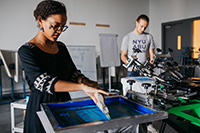Developing Broadband Wave Energy Converters
Harnessing wave energy has, for the longest times, been an area of continuous research around the globe. While point wave absorbers occupy 40 percent of the market share, they can only transduce energy efficiently within a very narrow wave frequency bandwidth leaving most of the wave energy unharnessed. To alleviate this problem, we are proposing a new design approach which can alleviate this shortcoming and increase the efficiency of point wave absorbers. This would push the performance limits of current point wave energy absorbers making the technology more viable especially for intermediate wave power levels similar to those observed in the Arabian gulf. The key enabling feature of the proposed design is the use of nonlinear (bi-stable) restoring force elements to replace the linear springs currently used to create the restoring force in the design of the generator. The idea of using nonlinear restoring elements stems from the knowledge that stiffness nonlinearities can widen the response bandwidth of an oscillator by creating amplitude frequency dependence. A similar concept has been applied successfully by our group to broaden the bandwidth of vibration-based energy harvesters which suffer from similar bandwidth issues. It is proposed here to adapt this same concept to point wave energy converters.


